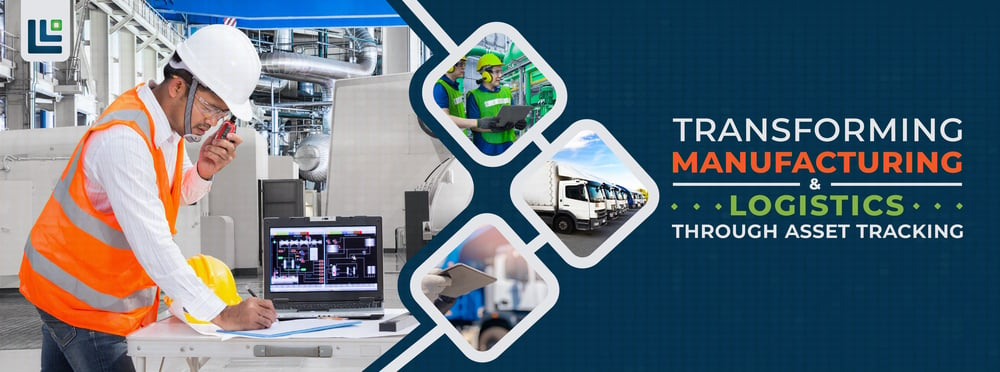Companies are constantly looking for ways to improve manufacturing and logistics operations. One of the best ways for companies to transform these operations is by implementing asset tracking technology. Get an overview of our top blogs from the campaign to learn how asset tracking is revolutionizing these operations.
The Four C's of a Great Asset Tracking Solution
Manufacturers and logistics companies are busy looking for asset tracking solutions to help them improve efficiencies. Many are stuck because there are so many solutions to choose from, and they don’t know which features are best to include. If this sounds like you, you would benefit from learning the top four features of a great asset tracking solution.
Read Blog
Why Manually Tracking WIP Doesn't Work Anymore
Tracking work in process (WIP) is essential for manufacturers so they have complete visibility of their production process and can make improvements where needed. In the past, companies have manually kept track of their processes with a spreadsheet or barcodes, leaving room for error. Technology has been innovated to create an automatic way to track WIP.
Read Blog
The Top 5 Technology Trends of 2023
Each year, new technology trends emerge that affect manufacturers and logistics operations. Staying up to date with these trends is essential to getting ahead of competitors. Are you aware of the IoT trends dominating in 2023? How prepared for these trends are you?
Read Blog
The OT and IT of Asset Tracking
When researching asset tracking, you probably see the terms IT and OT used a lot. Understanding these technologies and how they work together is essential to your success in using asset tracking.
Read Blog
Seven Methods of Asset Tracking
Almost every company can benefit from using asset tracking, but each company uses it differently. Because each use case is different, there are a few asset tracking methods and technologies to choose from.
Read Blog
What is the Best Way to Track Inventory?
When it comes to inventory management, you want to ensure that you have the right inventory, at the right place, at the right time, and in the right condition. This is important so processes can be completed properly and on time. It’s difficult to enforce this unless you have an asset tracking solution to help by automation.
Read Blog
How to Boost Your Bottom Line with Returnable Pallet Tracking
Did you know an easy way to boost your bottom line is by using returnable pallets? Your company can save a lot of money by reusing pallets after each use instead of disposing of them. Using returnable pallets comes with its risks; these pallets can get lost in transit. Asset tracking technology provides visibility of the pallets to help you avoid these costly losses.
Read Blog
How Asset Tracking Amplifies the Value of Workers
Asset tracking provides value to companies by providing visibility of assets and increasing efficiency. Did you know that the benefits asset tracking provides also benefit the employees of the company? The value of workers drastically increases by implementing an IoT asset tracking solution.
Read Blog
Preventing Equipment Theft Through Tracking
Equipment theft is a costly issue a lot of manufacturers face. High-value equipment draws in the temptation to steal and sell equipment leading to high replacement costs and delays in production. Tracking your equipment deters employees from theft and in the case of theft, you can see where the equipment ended up to you can get it back without having to replace it.
Read Blog
Why is Asset Tracking Taking Over Healthcare Logistics Companies?
Transporting medical equipment is an important task, but managing the healthcare supply chain is difficult to do because loss can easily occur. What’s a simple and cost-effective way to reduce loss during transit? Asset tracking; it provides visibility of the supply chain and helps companies ensure the safe transportation of medical equipment and medication.
Read Blog
Is Your Cold Chain Compliant?
Being compliant is one of the most important responsibilities a company has. Especially since the FDA has a regulation in place to prevent food borne illness. The simplest way to be in compliance is the implement an IoT asset tracking system that has embedded sensors to monitor temperature and inform managers of temperature changes.
Read Blog
How to Better Manage Your Tools with IoT
In massive warehouses, it’s difficult to manage every tool in the facility. Tools can easily be lost and mixed up. Between keeping up with maintenance and managing tool usage, having automation provides companies have complete visibility of their most important tools so processes are as optimized as possible.
Read Blog
Why IoT Technology Matters in Logistics?
IoT technology is revolutionizing the logistics industry. It’s led to optimized routing, increased customer satisfaction, better documentation management, and much more.
Read Blog
Shipment Monitoring Just Got Easier!
Without IoT technology, monitoring shipments is difficult; but because of technology, it doesn’t have to be. An RTLS solution provides real-time information about your non-powered assets including where they are and any shock or temperature information.
Read Blog
5 Reasons Manufacturing Companies are Increasing IoT Spending
Have you noticed a lot of manufacturing companies are investing in IoT technology? Manufacturers have found out that using IoT improves productivity, promotes employee and customer satisfaction, helps to stay ahead of the competition, and more.
Read Blog
The Impact of Warehouse Automation
Since the introduction of Industry 4.0, companies have been automating their warehouses. No matter what level of automation you choose for your warehouse, you’ll find some way to benefit from automating your warehouse. Whether automation for you means using a conveyor belt or monitoring the location of tools and equipment using real-time location technology, the positive impact automation has is irrepetible.
Read Blog
Preventing Overprocessing with WIP Tracking
Overprocessing is something you don’t want to struggle with as a manufacturer. It leads to prolonged production times and potentially ruined inventory. With all the moving parts in a plant, it’s easy to overlook reprocessing issues; tracking WIP with IoT technology provides managers with visibility of their production process. With more visibility, they can better manage finished inventory so it isn’t reprocessed.
Read Blog
What to Ask Yourself When Selecting an Asset Tracking Solution
Selecting an asset tracking solution can be complicated. Each solution offers different features to provide different benefits. Depending on which assets you want to track and why, one solution may be better than another. Evaluating your needs compared to product offering can be difficult to do and it’s difficult to know which questions to ask, that’s why we provided some guidance.
Read Blog
Join the AirFinder Difference!
- Innovation. Organizations can be freed up to innovate and bring more impactful products and services to market.
- Profitability. Increased profitability provides new opportunities to innovate and improve valuation.
- Digital Transformation. Discover competitive advantages, new revenue opportunities, improved customer relationships, and increased efficiency.
Why You Should Improve Logistics Processes with RTLS
As a company, you always want to look for a way to improve. While your current processes may work fine, improvements always lead to more sales and optimized processes. An RTLS (real-time location system) is one tool you can use to improve your company.
Read Blog
3 Ways Automation Promotes Employee Satisfaction
Automation typically has a negative connotation among employees. Many are concerned that automating parts of the warehouse will cause them to lose their job, but that’s not the case. Automating certain processes allows employees to spend their time doing their actual job instead of searching for what they need to do their job.
Read Blog
Where is Industry 4.0 Headed?
The fourth industrial revolution has been around for over a decade and has already had a tremendous impact on manufacturers. Industry 4.0 has provided a way for manufacturers to automate their facilities, allowing for interconnectivity and real-time visibility. The fourth industrial revolution isn’t over yet and the best is yet to come.
Read Blog
Extending Remaining Useful Life (RUL) with Asset Tracking
Knowing how much life a piece of equipment has is important for managers to know so they can make informed decisions when purchasing equipment. Knowing the RUL isn’t everything though; if you keep up with preventative maintenance, you’ll extend the RUL of equipment.
Read Blog
Enhancing Construction Through Asset Tracking
Managing construction sites is an important task. An improperly managed site means employee safety is at risk and equipment is at risk of theft. To properly and easily manage your site, technology may be of help.
Read Blog
How Logistics Companies are Overcoming Challenges
Every logistics company faces challenges. What’s most important is how those challenges are overcome. The simplest way to overcome challenges is by implementing technology into existing processes.
Read Blog
The Transformative Power of Predictive Planning
If your plan is to always react to problems, your company will suffer greatly because of large costs. Instead, the best option is to plan for the situations you can, focus on continuous improvement, and save reactive problem-solving for the truly unexpected, rare occasion.
Read Blog
Supply Chain Inefficiencies? Asset Tracking to the Rescue
If your supply chain isn’t as efficient as possible, you’re risking falling behind the competition. Asset tracking technology was designed to optimize supply chains so companies can cut costs and improve productivity and performance.
Read Blog
The Impact of Converging Technology
As time goes on, technology advances. One of the ways technology is advanced is by combining complex technologies in one solution. Everyone knows that Bluetooth Low Energy (LE) and Ultra Wideband (UWB) are common technologies used for asset tracking, but what you may not know is that they can both be used in the same system to help you solve more of your problems.
Read Blog
Meeting Industry Regulations with Asset Tracking
No matter the industry you operate in, you have regulations you must follow. When regulations are not met, your company faces financial consequences and will have a hurt brand reputation. Our asset tracking solution has embedded sensors to help companies ensure industry standards are being met.
Read Blog
Using Industry and IoT Trends to Prepare for the Future
Whether you’re a logistics company or manufacturer, there are trends within your industry you need to be aware of. The most important and latest trends surround IoT technology. If you’re not keeping up with these trends, you’re risking falling behind your competitors.
Read Blog
The Future of Link Labs Technology
There are a few factors driving the future of our technology. One of the main drivers is our partners. Our partners are taking our solution to the next level. The immediate future at Link Labs includes integrating solutions, meaning we’re bringing together the best location technologies to create an affordable and accurate solution.
Read Blog
Promoting Operational Resilience with Asset Tracking
Managing operational risk is essential to having a successful company. One of the best ways to manage risk is to do predictive planning. When you plan ahead for problems, you can avoid them and be prepared for the ones you can’t avoid. If you know how to address a specific problem, you don’t have to be stressed when it comes up; you just have to take the actions you planned to solve the problem.
Read Blog
How is Asset Tracking Transforming Manufacturing and Logistics Operations?
During this campaign, we discussed numerous ways asset tracking technology has transformed manufacturing and logistics operations, but it’s not done yet. With all the technological advancements going on now and being planned for the future, keep an eye out for what’s to come and how those innovations will further revolutionize these operations. Book a demo with us to learn how we’re contributing to the future of asset tracking technology.





